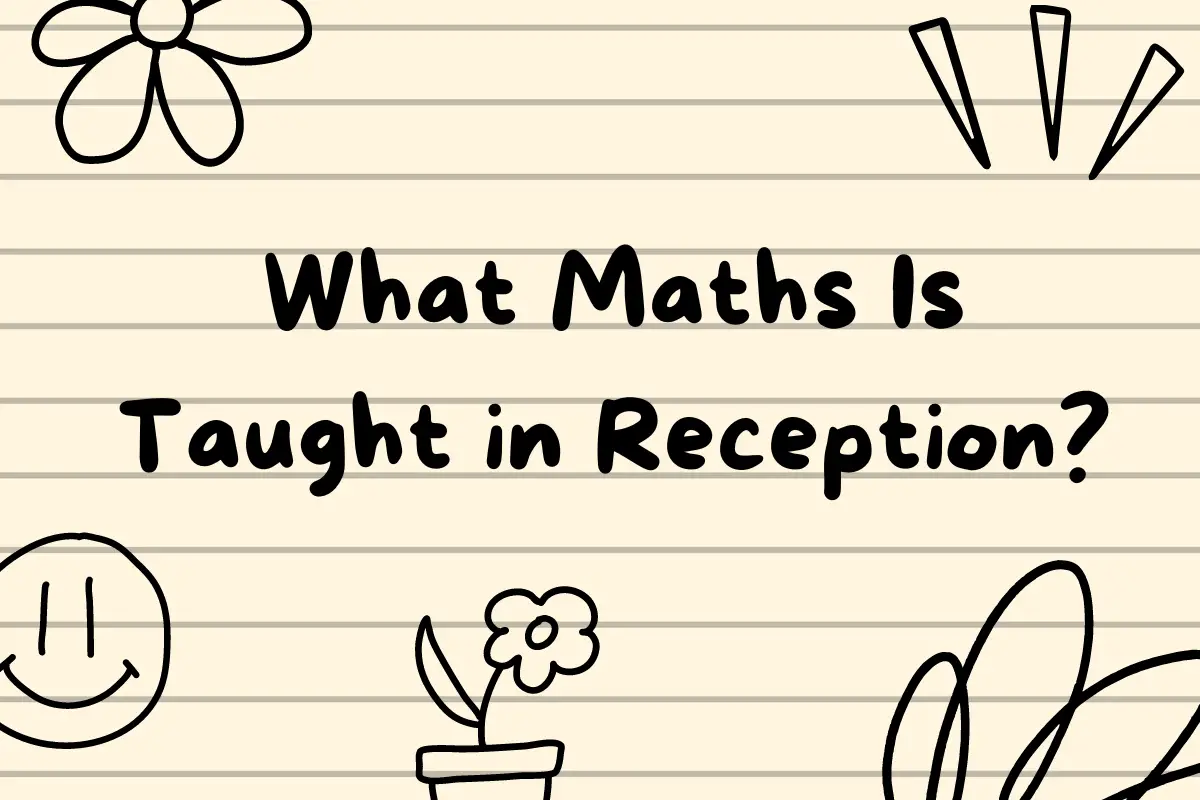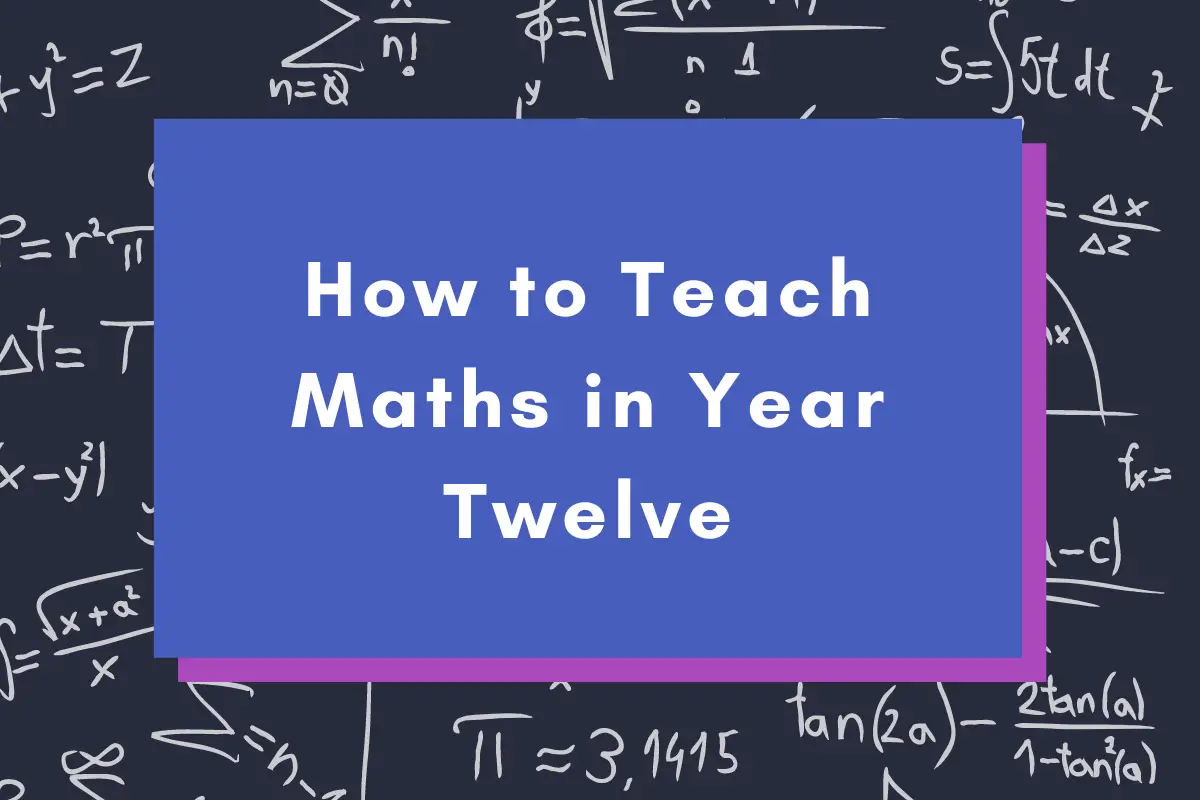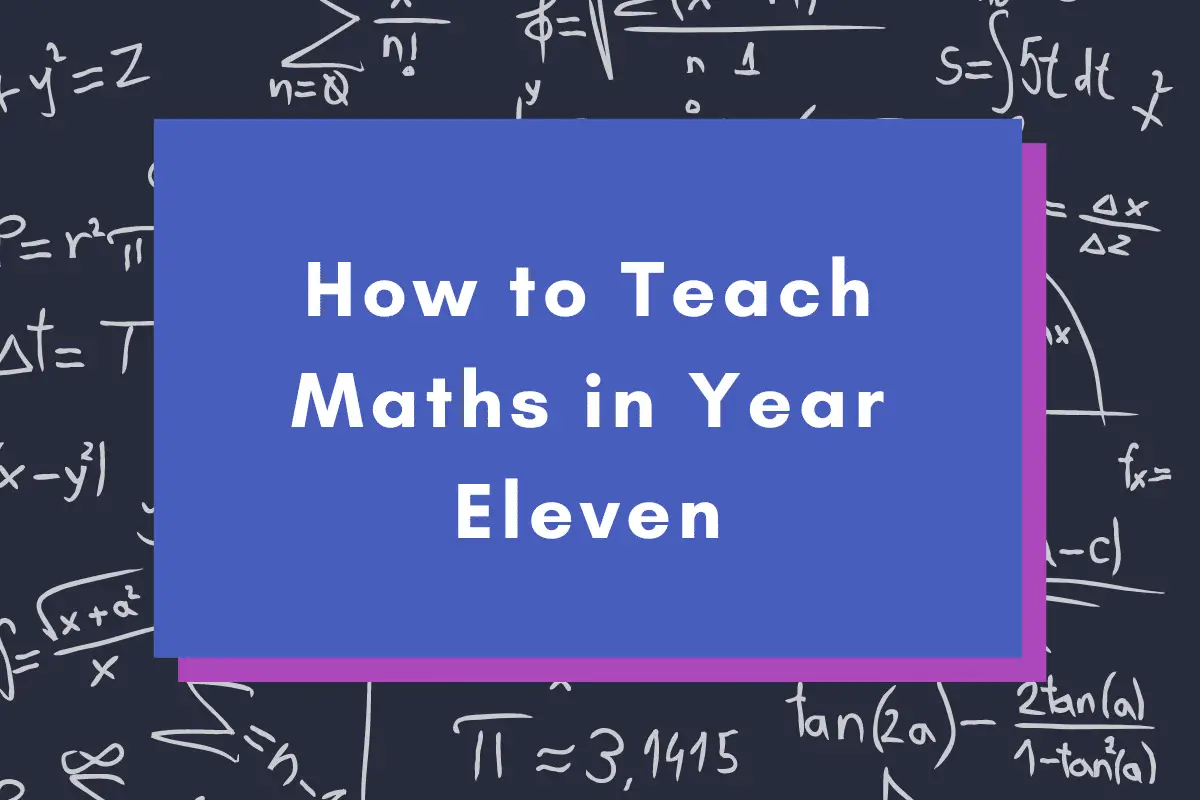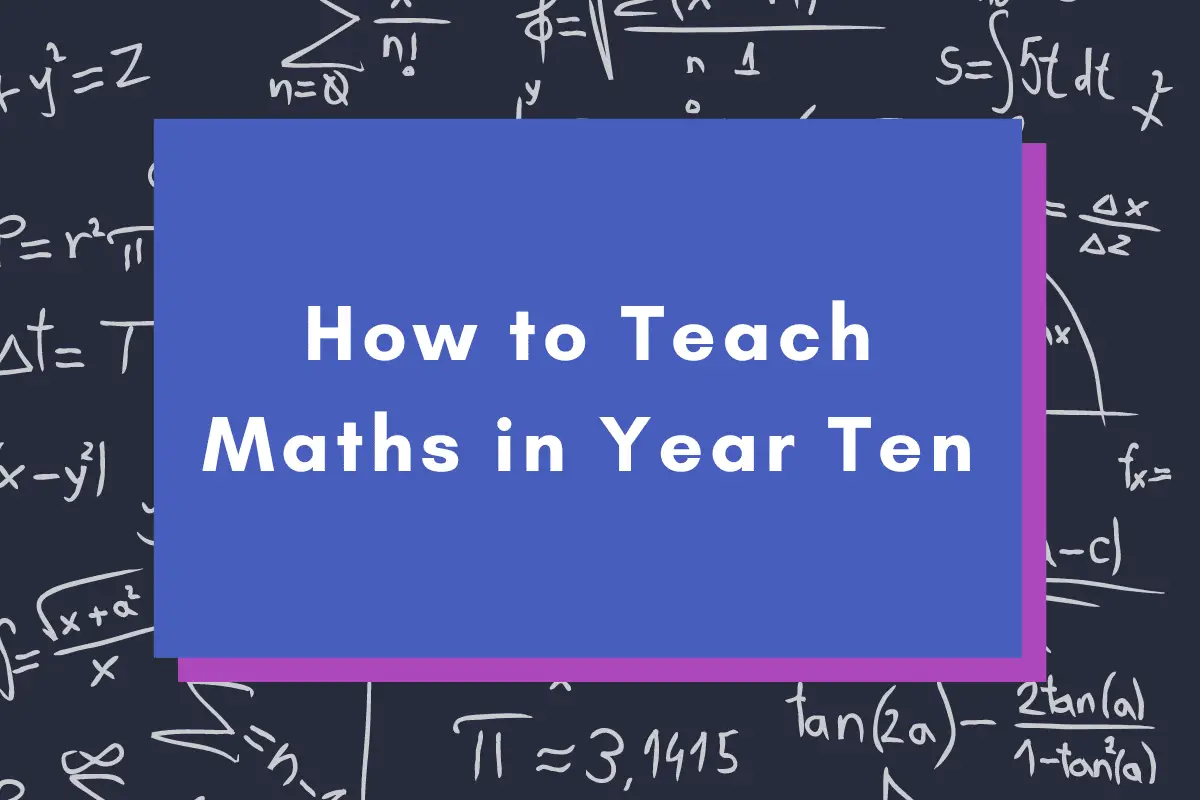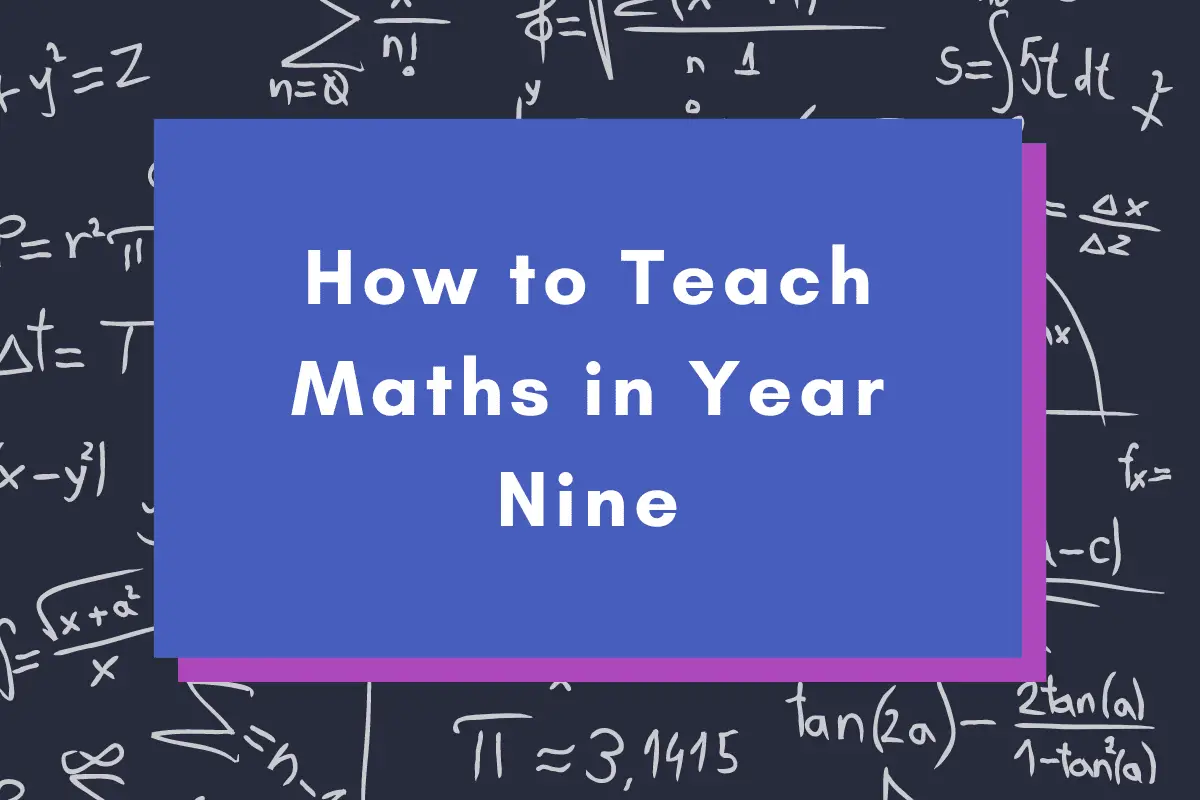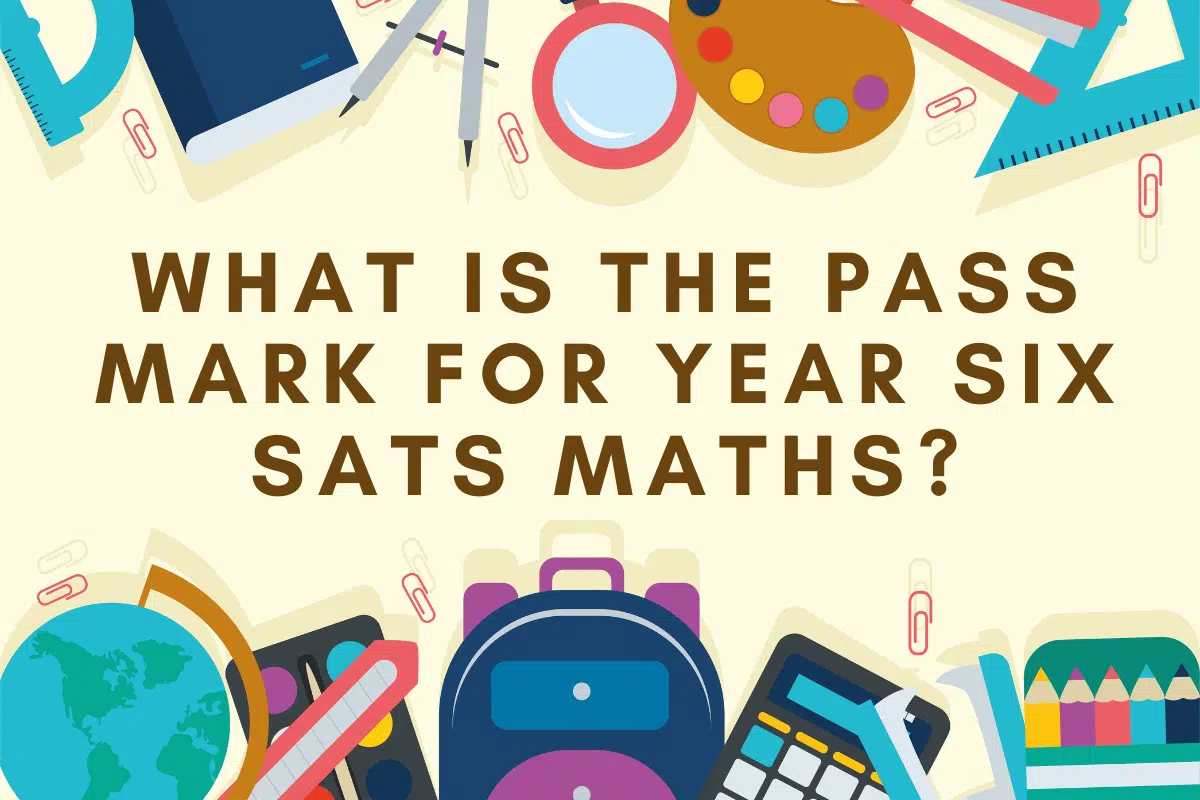Teaching maths to Year 8 students presents a unique opportunity to consolidate the foundational knowledge they have built in earlier years while introducing them to more complex concepts that will set the stage for their future studies.
At this stage, it is essential to emphasise the understanding of mathematical principles and provide a variety of contexts in which to apply them.
Effective teaching strategies include offering clear explanations, using graphical representations, and encouraging the construction of mathematical proofs or counter-examples.
Related: For more, check out our article on How To Use Concrete, Pictorial and Abstract Resources In Maths

As students’ mathematical reasoning and problem-solving skills advance, it becomes important to challenge them with real-world problems that require them to apply their knowledge in new and unfamiliar situations.
Teaching maths creatively can keep students engaged and help solidify their understanding.
In Year 8, a focus on ratios, proportions, percentages, along with expanding geometric and measurement knowledge, prepares students for successful progression in their mathematical education.
Key Takeaways
- Establishing a strong grasp of fundamental maths concepts is critical in Year 8.
- Encouraging problem-solving and reasoning is essential for mathematical development.
- Creative and applied learning approaches enhance student engagement in maths.
Related: For more, check out our article on How To Teach Maths In Year Seven
Understanding the Fundamentals of Maths
In Year 8, as part of the maths curriculum, students build on their Year 7 foundation, gaining deeper fluency in number sense and place value, beginning to explore foundational algebra concepts, and understanding basic geometric principles.
Number Sense and Place Value
Number sense is a foundational skill in the Year 8 maths curriculum that helps students understand and work with numbers efficiently.
It involves recognising how numbers function and relate to one another, and grasping the significance of place value in our number system. By Year 8, students should be able to:
- Perform operations with both whole numbers and decimals.
- Understand and use powers of ten and the relationships between units—such as converting between different units like kilograms to grams.
Foundational Algebra Concepts
Algebra forms a core part of the Year 8 maths skills, where students learn to manipulate mathematical symbols and expressions to solve problems. In foundational algebra, they cover:
- Understanding and using variables to represent numbers.
- Simplifying expressions and solving equations, fostering their ability to reason abstractly and structurally.
Basic Geometric Principles
Geometry in Year 8 maths work focuses on the properties and relationships of shapes and spaces. Students should be able to:
- Identify and measure angles, lines, and symmetry in two-dimensional shapes.
- Calculate the area and perimeter of a variety of shapes, and begin to explore the volume of three-dimensional objects.
The teacher’s role is critical in guiding students through these topics, ensuring they not only learn the mechanics but also understand the underlying principles.
Related: For more, check out our article on How To Teach Year Six Maths
Exploring Ratios, Proportions, and Percentages
In Year Eight mathematics, students should solidify their understanding of the relationship between ratios, proportions, and percentages as fundamental concepts for numerous applications in mathematics and real-life situations.
Mastering Ratios and Proportions
When teaching ratios and proportions, it’s important to start with clarifying that a ratio compares two or more quantities, denoting the relative size of one quantity to another, such as “2:3” indicating for every 2 units of the first quantity, there are 3 of the second.
On the other hand, a proportion is an equation that states two ratios are equivalent.
Students should practice setting up ratios from given information, ensuring they can interpret language and context to form correct comparisons.
They can then move on to solving problems involving direct or inverse proportions, where quantities increase or decrease in relation to one another. Emphasise the importance of units and consistent use of terms.
- Example: If 5 pencils cost £1.25, find the cost of 8 pencils.
- Answer: Using direct proportion, ( \frac{5}{1.25} = \frac{8}{x} ) solving for ( x ) gives the cost for 8 pencils.
Calculating Percentages and Fractions
Understanding the transition between fractions, decimals, and percentages is a critical skill. Begin by explaining that a fraction represents a part of a whole, while a percentage is a fraction whose denominator is 100.
A decimal is another way to represent fractions and percentages. Teaching how to express one form in the other two should be emphasised, using practical examples and exercises to reinforce the concepts.
- Convert fractions to decimals: Divide the top number by the bottom number, e.g., ( \frac{3}{4} = 0.75 ).
- Convert decimals to percentages: Multiply by 100 and add the % symbol, e.g., ( 0.75 \times 100 = 75% ).
- Convert percentages to fractions: Write the percentage over 100 and simplify, e.g., ( 75% = \frac{75}{100} = \frac{3}{4} ).
By practising a variety of problems, students enhance their numerical fluency in moving seamlessly between ratios, fractions, decimals, and percentages, which lays the groundwork for more advanced mathematical concepts.
Related: For more, check out our article on How To Use Maths In Year Five
Diving into Advanced Topics
When Year 8 students encounter advanced topics in mathematics, they must build a strong foundation in probability and statistics that will underpin their ability to analyse data and predict outcomes.
Developing Probability Skills
In Year 8, students enhance their understanding of probability, which involves predicting the likelihood of different outcomes.
Emphasising practical activities that make abstract concepts concrete can be effective. For instance, they might use a probability scale from 0 to 1 to represent impossible and certain events, respectively. When teaching probability:
- Analyse simple events and their outcomes using frequency trees or probability trees.
- Understand and apply terms such as dependent and independent events.
- Calculate the probability of combined events using formulas.
A practical approach to probability may involve rolling dice or drawing coloured balls from a bag, followed by charting the outcomes to visually demonstrate the concept of probable versus less probable events.
Engaging with Statistics and Data
Statistics takes a prominent role in Year 8 maths, as students delve into data interpretation and representation. Through real-world examples, students begin to:
- Calculate measures of central tendency such as the mean, median, mode, and understand the importance of each in different contexts.
- Determine the range and other measures of dispersion to understand the spread of data sets.
Exercises often involve real-life data, which helps students draw meaningful conclusions. They learn to construct and interpret a variety of graphs and charts, such as histograms and box plots.
Utilising technology, such as spreadsheet software, can enhance their engagement by providing an instant visual representation of data as they learn to manoeuvre through large data sets, plot points, and observe trends.
Related: For more, check out our article on How To Teach Year Four Maths
Expanding Geometric and Measurement Knowledge
In Year 8, students should focus on enhancing their understanding of geometric shapes and the skills needed for measuring different dimensions.
Building on primary-level foundations, the curriculum moves towards more complex concepts such as volume and surface area, integrating algebraic techniques where necessary.
Understanding Shapes and Solids
Year 8 students will encounter a variety of shapes and solids, learning to identify and describe their properties.
Polygons become a point of focus, with emphasis on classifying types like trapeziums based on sides and angles. Circles are studied in detail, where students must understand terms such as radius, diameter, circumference, and pi (π).
- Lines and Angles: This includes knowledge of parallel, perpendicular lines, and the calculation of angles in various contexts.
- Symmetry and Congruence: Pupils explore line and rotational symmetry and the conditions for the congruence of triangles and other polygons.
- 3D Shapes: They delve into three-dimensional shapes, learning to visualise and represent prisms, pyramids, and spheres.
Measuring Area, Perimeter, and Volume
Accurate measurement of area, perimeter, and volume is integral to the Year 8 maths experience.
Their applications are numerous, extending to real-world situations such as calculating materials needed for a project or understanding geographical space.
- Area and Perimeter: These concepts are applied to various shapes, requiring students to master formulae for squares, rectangles, triangles, and complex polygons. Utilisation of algebra can come into play when working with variables.
- Volume and Surface Area: Students learn to calculate the volume of cubes, cuboids, and more complex solids like cylinders. Real-life applications, like determining the amount needed to fill containers, solidify their understanding. Calculation of surface area involves breaking down solids into their nets.
Through these subsections, students enhance their practical and theoretical understanding of geometry and measurement, setting a solid foundation for further mathematical education.
Related: For more, check out our article on How To Use Teach Maths in Year Three
Problem-solving and Mathematical Reasoning

In Year Eight, students should focus on developing robust problem-solving capabilities and sharpen their mathematical reasoning.
These skills are key to understanding and working through various mathematical challenges.
Approaching Word Problems and Equations
When tackling word problems and equations, students must first learn to identify the relevant mathematical concepts involved.
They should practise converting textual information into mathematical expressions and equations. It helps to break down the word problem into manageable steps:
- Read the problem completely to understand the situation.
- Highlight key information and terms.
- Translate words into mathematical symbols and expressions.
- Use order of operations to simplify the expressions.
This systematic approach allows students to manage complex problems involving inequalities, indices, brackets, and linear equations by transforming them into solvable equations.
Applying Mathematical Reasoning in Context
Students should apply mathematical reasoning to real-life contexts, which involves more than just executing computations. They must understand when to perform expanding or simplifying expressions, apply powers and roots, and work with formulae.
Critical thinking is applied by deducing which transformations or coordinates are relevant to the problem at hand, often requiring:
- An estimation to gauge the reasonableness of an answer.
- Fluency in different problem-solving strategies.
- Working mathematically to interpret and solve problems.
They should be encouraged to justify their methods and solutions, not just in homework but through class discussions and written questions, to reinforce their understanding.
This process develops a clear mathematical communication skill, essential for higher levels of mathematics.
Related: For more, check out our article on How To Teach Maths In Year Two
Integrating Technology and Resources
The effective integration of technology and resources in Year 8 maths provides diverse and engaging ways for students to understand complex mathematical concepts.
From interactive activities to data visualisation, technology can enhance the learning experience significantly.
Utilising Graphs and Charts for Comprehension
Graphs and charts are essential in assisting Year 8 students to visualise data and understand relationships between numbers. Teachers can employ scatter graphs to display the correlation between variables or use line graphs for changes over time.
Bar charts and pie charts are useful in comparing different quantities, while Venn diagrams help visualise logical relationships. Interactive resources like Year 8 Maths Practice offer a variety of graphical tools to reinforce these concepts.
- Scatter Graphs: Visualise correlations
- Line Graphs: Show time-based changes
- Bar Charts: Compare quantities
- Pie Charts: Illustrate percentage or proportional data
- Venn Diagrams: Represent logical sets
Incorporating Educational Tools and Resources
In the Year 8 classroom, integrating a range of educational tools and resources can help teachers illustrate abstract maths concepts like ratios, expressions, and probabilities.
Websites such as Education.com offer worksheets and interactive games designed to support students in understanding multiplying multiples, dividing fractions, and more.
Utilising technology like digital frequency tables can aid in teaching sample space and probabilities, making complex ideas more tangible.
- Digital Frequency Tables: Teach probabilities and sample space
- Worksheets: Reinforce concepts like dividing fractions
- Interactive Games: Engage students in multiples and multiplication exercises
By incorporating technological resources into Year 8 maths lessons, educators can provide a multifaceted approach to learning that supports and enhances students’ ability to grasp and retain mathematical knowledge.
Related: For more, check out our article on How To Teach Maths In Year One
Frequently Asked Questions
In this section, key strategies are addressed for enhancing Year 8 students’ understanding of mathematical concepts, from algebra to the use of technology in the classroom.
What techniques are effective for teaching algebra to Year 8 students?
One particularly effective method involves utilising visual representations to help pupils grasp abstract algebraic concepts. Storytelling that incorporates algebraic thinking can also make the subject more relatable and engaging.
How can I best engage Year 8 pupils in learning geometry?
Interactive activities, including hands-on tasks with shapes and the use of dynamic geometry software, can engage students deeply in geometry. Bringing real-life context into lessons elevates interest and understanding of geometric concepts.
What resources are most beneficial for supporting Year 8 students with fractions and decimals?
Clear, structured worksheets and visual aids can significantly assist Year 8 students in understanding fractions and decimals. Online platforms offer adaptive learning paths that can reinforce these concepts effectively.
Which pedagogical approaches enhance Year 8 mathematical problem-solving skills?
Encouraging collaborative problem-solving and integrating real-world scenarios help Year 8 students develop key skills in mathematics. Scaffolding complex problems into manageable parts also fosters analytical thinking.
How should I assess the mathematical understanding of Year 8 learners consistently and effectively?
Frequent, low-stakes quizzes and personalised feedback allow for ongoing assessment of pupils’ mathematical understanding. Project-based tasks that require the application of various concepts also provide a comprehensive view of student learning.
In what ways can technology be integrated into the Year 8 maths curriculum to improve learning outcomes?
Technology can be used to enhance learning in several ways, such as incorporating educational apps for practising maths skills or utilising online graphing tools for students to explore and understand different types of functions and relations.

